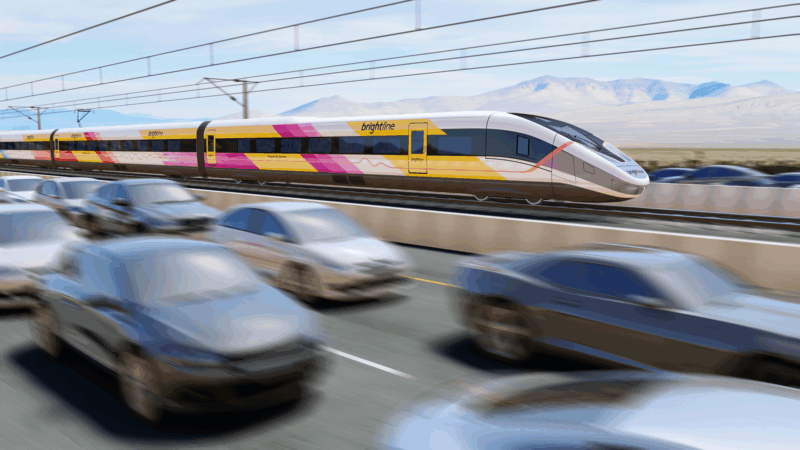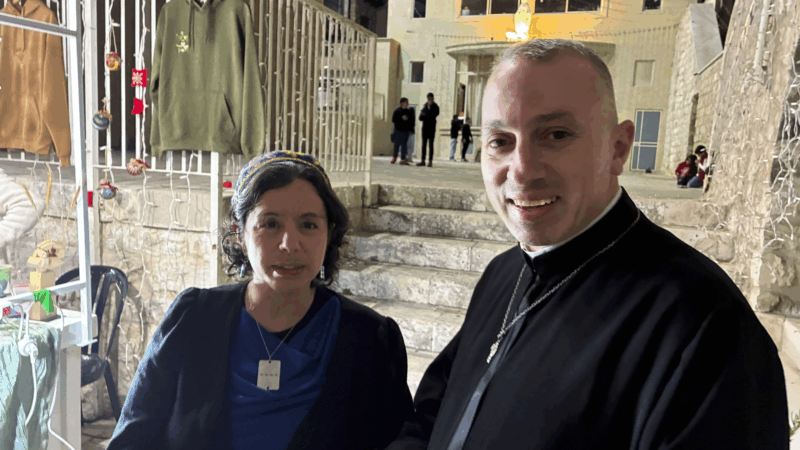High-speed train from California to Las Vegas tries to slow rising costs
RANCHO CUCAMONGA, Calif. — Brightline West aims to connect Las Vegas and Southern California with high-speed rail.
But the planned terminal is not in Los Angeles, where you might expect, but 40 miles east of downtown Los Angeles.
“We’ve got the best name. Who doesn’t want to say Rancho Cucamonga?,” asks Elisa Cox, assistant city manager for this town of about 170,000 near the foothills of the San Gabriel Mountains in Southern California’s Inland Empire.
This is where Brightline West plans to build a terminal to handle millions of travelers a year.
The company broke ground last year on what would be the first true high-speed rail line in the U.S., with trains that can make the 218-mile trip to Las Vegas in just over two hours. The project also aims to ease the notorious traffic congestion between L.A. and Las Vegas that frequently turns Interstate-15 into a parking lot.
But high-speed rail is expensive. So Brightline West has had to make some big compromises to keep costs down — for example, putting the terminal in Rancho Cucamonga instead of downtown L.A., and running track through the median of an interstate, to save on land acquisition costs.

Still, the project is expected to cost at least $12 billion dollars, and likely more. The company has raised about $6.5 billion so far in private financing and federal grants, but it’s warning investors that construction costs are rising. And skeptics worry whether the company can deliver on its promises.
“I think that there’s a lot of risk around it failing, and I wouldn’t have said that a year ago,” said Marc Joffe, a former analyst in the financial industry who’s now a visiting fellow at the California Policy Center, a conservative-leaning think tank.
Brightline’s existing service in South and Central Florida is falling short of its ridership and revenue projections, Joffe notes. And the company recently pushed off an interest payment in July, prompting some ratings agencies to downgrade its bonds.
Investors have some doubts about Brightline West as well, Joffe says, and he believes they’re right to be concerned.
“I think it’ll be late. I think it will generate less revenue than they expect. Between those two things, I don’t think it’ll be successful, at least from a financial point of view,” Joffe said in an interview.
The U.S. is one of the few wealthy countries in the world without a high-speed rail line that travels more than 180 miles per hour. Brightline West is betting it can change that. With top speeds of almost 200 miles per hour, these trains will be faster than Amtrak’s Acela service on the Northeast Corridor, or Brightline’s current service in Florida.
Even the Trump administration — which has tried to strip federal funding from another high-speed rail project in California — is on board with Brightline West so far.
“I would love to see high-speed rail in America,” said U.S. Transportation Secretary Sean Duffy last month. “I don’t think it should just be China, Europe, Japan, others that have high-speed rail.”
Brightline West declined an interview request for this story.
But Asha Jones, the vice president of corporate affairs, laid out some of the company’s plans in a virtual presentation for the board of the San Bernardino, Calif. County Transportation Authority in June. The link between Brightline West and the L.A. regional rail system will be seamless, she said.
“You’ll be able to buy one ticket that will take you from Las Vegas or any of the other pick-ups if you’re going to L.A. or wherever you’re going that Metrolink goes,” she said. “We want it to be quick and efficient.”
Building a terminal in Rancho Cucamonga instead of L.A. should save time and money. It’s not the only move the company has made to keep costs down. For much of the route, the company plans to put the track in the median of an interstate highway, so that it doesn’t have to acquire as much land.
But those compromises come with downsides. The decision to build a single track in the middle of the freeway will limit speeds, for example, and cap the number of trains.
Still, high-speed rail supporters see Brightline West as the best chance to get a train up and running in the U.S. At the groundbreaking in Las Vegas last year, then-transportation secretary Pete Buttigieg helped drive in one of the ceremonial spikes.
“I am firmly convinced that once the first customer buys that first ticket to ride true high-speed rail on American soil, there will be no going back,” Buttigieg said.

For Rancho Cucamonga, the imminent arrival of Brightline West is both a challenge and an opportunity.
“There is nowhere else in the United States that has high-speed rail,” said Elisa Cox, the assistant city manager, in an interview at the future site of Brightline West’s California terminal.
“There is nothing like it yet. So there isn’t necessarily another city to call up and say, like, ‘hey, how did you deal with X, Y, Z?,'” she said. “There is no other example.”
30 years ago, ‘Waiting to Exhale’ was the blockbuster Hollywood didn’t anticipate
The 1995 adaptation of Terry McMillan's novel celebrated the beauty of Black sisterhood.
In the snow, these salamanders get supercool
Blue spotted salamanders have been seen walking across snow and new research suggests how they get by in the cold.
Timothée Chalamet, a Neil Diamond tribute band and more in theaters for Christmas
Also in theaters this week, Jack Black and Paul Rudd star in a meta reimagining of Anaconda, Amanda Seyfried in a Shaker origin story, and Ralph Fiennes plays a World War I-era choirmaster.
When porch pirates steal medicine instead of holiday gifts
Mail theft can happen around the holidays, but sometimes, instead of getting a new iPad, the thief swipes a mail order medicine. Here's what to do about it.
U.S. and Ukraine reach consensus on key issues aimed at ending the war
The United States and Ukraine have reached a consensus on several critical issues, but sensitive issues around territorial control in Ukraine's eastern industrial heartland remain unresolved.
Despite Vatican-Israel tensions, Catholics and Jews work to build trust in Haifa
Religious leaders started getting together after Oct. 7, 2023, in the hope of preventing a repeat of Arab-Jewish violence that erupted after a previous conflict in Gaza two years earlier.









